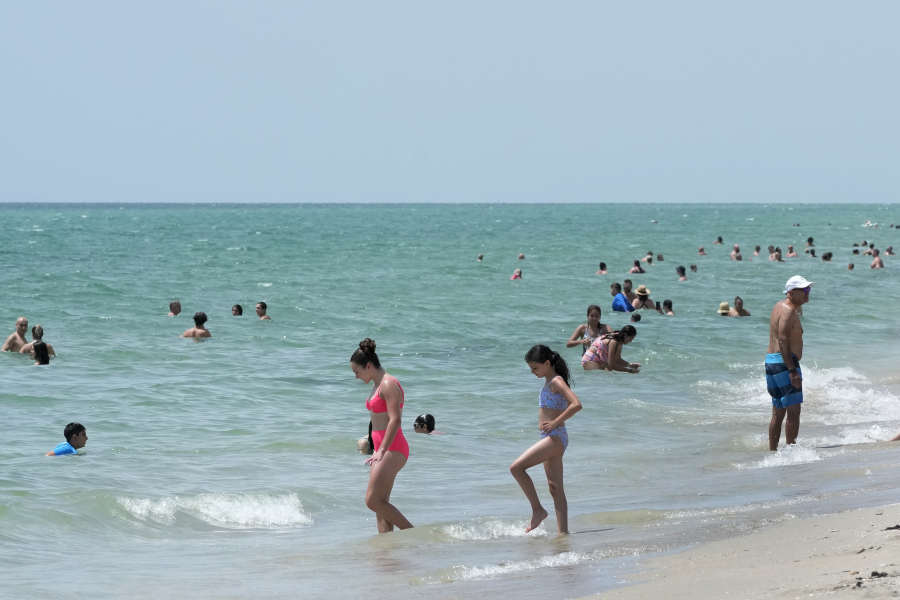ORLANDO, Fla. — Record global ocean heating has invaded Florida with a vengeance.
Water temperatures in the mid-90s are threatening delicate coral reefs, depriving swimmers of cooling dips and adding a bit more ick to the Sunshine State’s already oppressive summer weather. Forecasters are warning of temperatures that with humidity will feel like 110 degrees by week’s end.
If that’s not enough, Florida is about to get a dose of dust from Africa’s Saharan desert that’s likely to hurt air quality.
The globe is coming off a week of heat not seen in modern measurements, the World Meteorological Organization said Monday, using data from Japan’s weather agency to confirm unofficial records reported nearly daily last week by the University of Maine’s Climate Reanalyzer. Japan reported the global average temperature on Friday was half a degree warmer than its past record hottest day in August 2016.
Global sea surface temperatures have been record high since April and the North Atlantic has been off-the-charts hot since mid-March, meteorologists report as climate change is linked to more extreme and deadly events.
“We are in uncharted territory and we can expect more records to fall,” said WMO director of climate services Christopher Hewitt. “This is worrying news for the planet.”
Now it’s Florida’s turn.
Water temperature near Johnson Key came close to 96 degrees Sunday evening, according to a National Oceanic and Atmospheric Administration buoy. Another buoy had a reading close to 95 near Vaca Key. These are about 5 degrees warmer than normal this time of year, meteorologists said.
“That’s incredible,” said National Weather Service meteorologist Andrew Orrison. “The water is so warm you really can’t cool off.”
While the 95- and 96-degree readings were in shallow waters, “the water temperatures are 90 to 93 degrees Fahrenheit around much of Florida, which is extremely warm,” said University of Miami hurricane researcher Brian McNoldy. He said his 95-degree pool doesn’t cool him — it just leaves him wet.
Water temperatures across the Gulf of Mexico and Southwest Atlantic are 4 to 5 degrees warmer than normal, Orrison said. Because the water is so warm, the air in Florida gets more humid and “that’s making things tougher or more oppressive for people who are going to be out and about,” he said.
The heat dome that baked Texas and Mexico for much of the early summer has oozed its way to Florida with sunshine, little to no cooling clouds or rain, but humidity worsened by the hot oceans, Orrison and McNoldy said.
Not only will it stick around for a while as weather patterns seem stuck — a sign of climate change, some scientists contend — “it may actually tend to get a little bit worse,” Orrison said, with extra heat and humidity that has NOAA forecasting a heat index around 110 by weekend.
It could be worse. Air temperatures of 110 are forecast for the U.S. Southwest, including Arizona, New Mexico and southeast California, Orrison said. Death Valley should see highs of 120 to 125 by the end of the week, and possibly a highly unusual 130.
Scientists worry about the coral in that warmed-up water.
“There’s a good chance of heat stress accumulating very early in the season so we could be looking at nasty bleaching,” said International Coral Reef Society’s Mark Eakin, a retired top NOAA coral reef scientist. Bleaching weakens coral; it takes extended heat to kill it.
“We are already receiving reports of bleaching from Belize, which is very alarming this early in the summer,” said scientist Liv Williamson of the University of Miami’s Coral Reef Futures Lab. She said global projections give a 90 percent chance for major bleaching on many reefs, including in Pacific Islands along the Equator, the eastern tropical Pacific in Panama, the Caribbean coast of Central America, and in Florida.
“This is only July, this heat will just keep accumulating and these corals will be forced to deal with dangerously warm conditions for much longer than is normal,” Williamson said in an email.
Coral bleaching and die-offs are becoming more frequent with climate change, especially during an El Nino, Williamson said.



